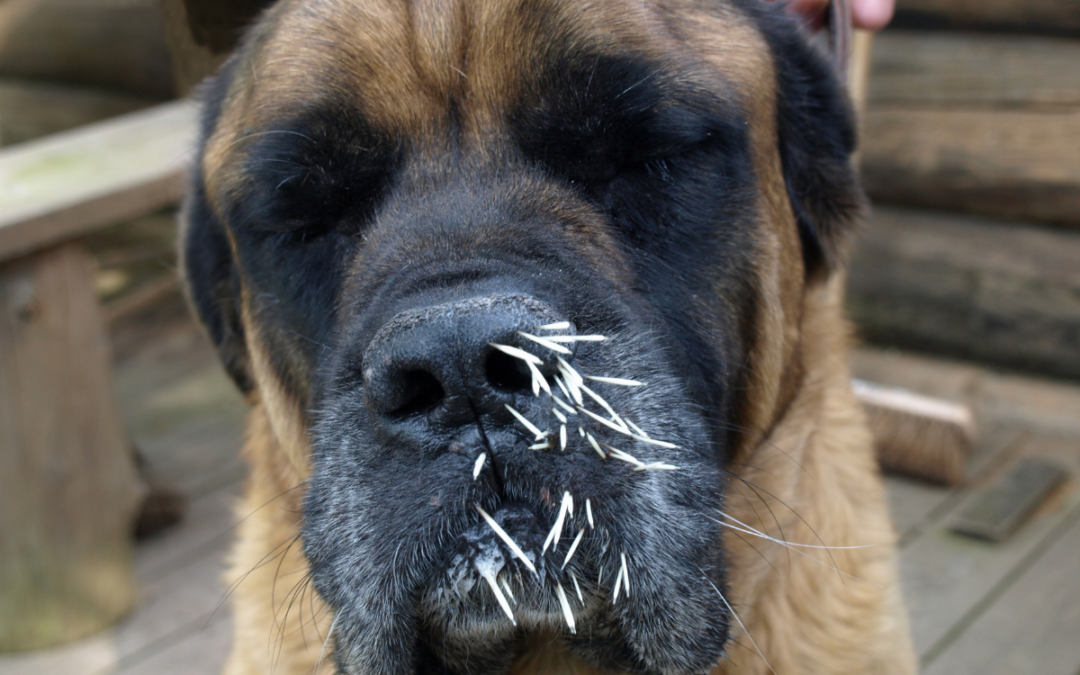As springtime approaches and people and their pets start spending more time outside, our Emergency & Critical Care Services team always sees an increase in porcupine quilling injuries. Although they say curiosity killed the cat, in our experience, it’s dogs who tend to be the most frequent victims of porcupine quillings. Here’s how to avoid them, and what to do if your dog encounters this slow-moving but dangerous rodent and ends up in a “prickly” situation.
All About Porcupine Quills
First, a few myths to bust about porcupines. Contrary to popular belief, they don’t shoot their quills from a distance. They aren’t aggressive, but they are defensive, so if they feel threatened, they will defend themselves, their young, and their dens.
Porcupines use their quills in two main ways: They swing their tails, clubbing their attacker, and also raise the quills on their back when threatened. If your dog is close enough, quills that come in contact with your dog’s skin will quickly detach from the porcupine and onto your dog. The end of the quill has a barb on it with spikes that angle backwards, making them easily embedded and difficult to remove.
Porcupine quills are dangerous to your dog. If not removed right away, they can move through your dog’s body cavities and muscle, and may penetrate your dog’s internal organs, ear drums, or eyes. Their needle-like shape can easily introduce bacteria and lead to life-threatening infection.
What to Do If Your Dog Is Quilled
If your dog experiences a porcupine quilling, don’t panic. Your first step will be to get your dog away from the porcupine without touching any of the quills yourself. Porcupine quillings are painful, and your dog’s first reaction might be to rub their face against the first thing they come in contact with. Try not to let your dog rub the quills, which may cause them to become even more deeply embedded.
Next, call your dog’s primary veterinarian or bring them to BEVS emergency service as soon as possible. Quills must be removed immediately, before they begin to migrate. Don’t try to remove the quills yourself, as it can be very painful for your dog, and also cause the quills to break, making them more likely to migrate deeper into tissue. If quills do migrate, further diagnostic testing such as a CT scan may be needed. Veterinary intervention is the best way to ensure the safety and comfort of your dog.
Dogs may need deep sedation or general anesthesia to remove porcupine quills. Any quills that cannot be removed must be closely monitored for migration and any complications that may arise.
Be sure to follow your veterinarian’s discharge instructions carefully, and administer and finish all medications as they are prescribed. Your pet may be sore and painful for a few days after the procedure, so allow them plenty of quiet and rest and monitor them carefully while they recover.
How to Prevent Porcupine Quillings
Unfortunately, most dogs who get into trouble with porcupines do not learn from their mistakes. Porcupines tend to use the same den year after year, so if you’ve had porcupines in your area in the past, chances are you will again.
The best way to prevent quillings is to avoid encountering porcupines at all.
- Avoid letting your dog roam at dawn or after dusk
- Do not let your dog go into areas with known porcupine dens
- Keep your dog on a leash/harness while walking or hiking, especially in the woods or field edges
- Teach your dog to avoid porcupines with positive reinforcement training
- Teach your dog an emergency recall cue that you only use in emergency situations
If your dog has experienced a porcupine quilling, or if you have questions about porcupine quillings in pets, please don’t hesitate to contact us. We are here for you 24/7.

